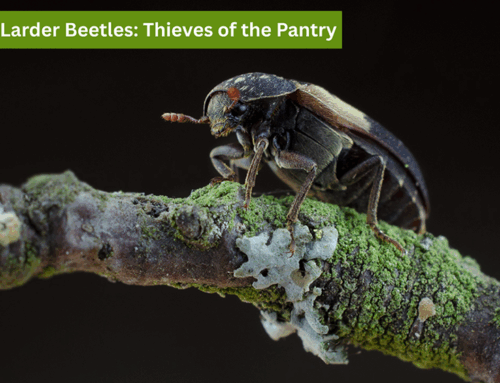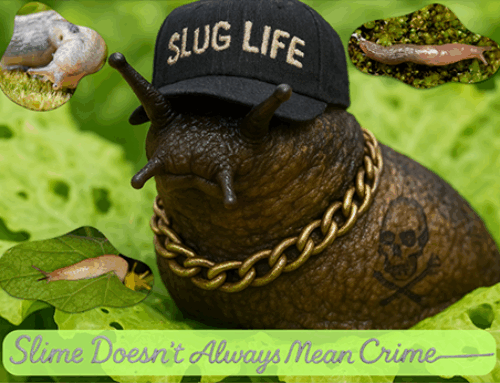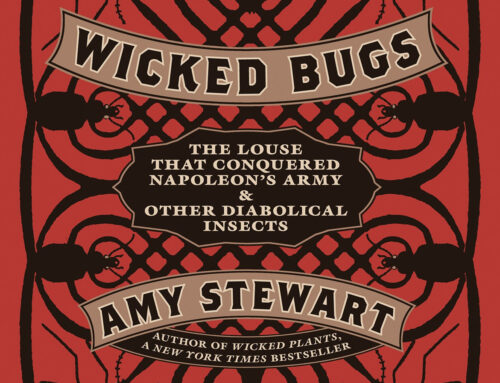Scarlet Lily Beetles: A Growing Threat
by Brett Kerley
Scarlet Lily Beetles or red lily beetles (Lilioceris lilii), are visually striking but highly destructive insects. They have become a common garden pest in Edmonton. Introduced to Canada in the 1940s, this invasive species has made its way west, establishing itself in Alberta in the early 2010s. Gardeners and horticulturists battle this pest annually as it targets true lilies (Lilium spp.) and fritillaries (Fritillaria spp.).
Identification
The adult scarlet lily beetle is easy to spot.
- Size: 0.25–0.35 inches (6–9 mm) long
- Color: Bright red wing covers (elytra), with black legs, head, and underside
- Shape: Smooth, elongated body with a hard shell
The larvae are less obvious. They are soft-bodied, dark brown to black, and covered in a self-made coating of feces, which camouflages them from predators. They mainly hang out on the underside of leaves.
The eggs are small and bright orange, also laid on the underside of the leaves.

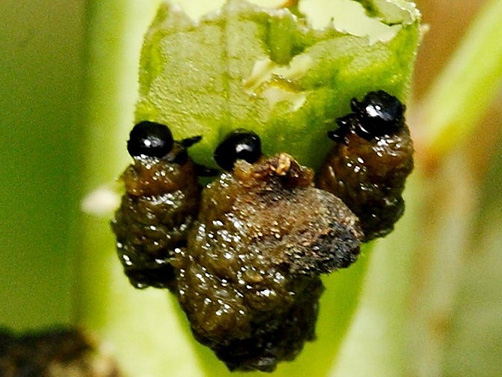
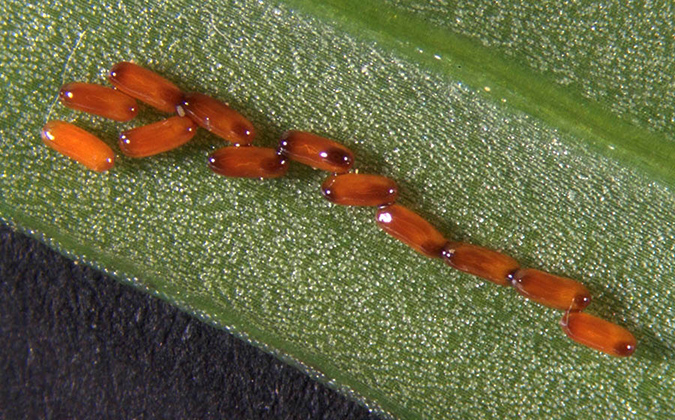
Life Cycle
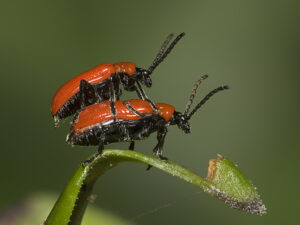
Scarlet lily beetles mating
- Spring (April–May): Adults emerge from overwintering and begin feeding and mating.
- Late Spring: Eggs are laid in rows on the underside of lily leaves.
- Early to Mid-Summer: Larvae hatch and feed heavily on foliage, buds, and stems.
- Late Summer: Larvae drop to the ground to pupate. New adults emerge and feed before overwintering.
In Edmonton’s climate, there’s typically one generation per year.
Lilies Less Susceptible to Beetle Damage
Some varieties of lilies are less attractive or more resistant:
- Martagon lilies (Lilium martagon): Tough, waxy foliage and late emergence deter feeding
- Turk’s Cap lilies (L. superbum, L. tsingtauense): Similar benefits to martagons
- Species lilies with narrow or coarse leaves are less preferred
- Hybrid crosses bred for resistance may be worth exploring
While none are immune, these types may have reduced beetle damage in vulnerable gardens.
Management and Control
Controlling the scarlet lily beetle involves combining multiple strategies:
Manual Removal
- Inspect daily in spring and early summer
- Hand-pick beetles, larvae, and eggs; drown in soapy water or just squish them in your gardening gloves.
- Crush egg clusters found on leaf undersides
Chemical & Natural Controls
Dr. Doom House & Garden Spray uses pyrethrins (natural insecticides derived from chrysanthemum flowers) as its active ingredient.
- Contact Kill: Pyrethrins kill insects by attacking their nervous system. When sprayed directly on lily beetles (adults or larvae), it causes paralysis and death fairly quickly.
- Short Residual Effect: Pyrethrins break down rapidly in sunlight, so the spray doesn’t remain effective for long. It must be reapplied if more beetles appear.
- Ovicidal (Egg-Killing) Effect: It’s not very effective on beetle eggs, so controlling larvae and adults is key.
Effectiveness:
- Applied directly to beetles or larvae (especially the disgusting larval stage, which covers itself in excrement).
- Used in cooler parts of the day (early morning or evening) to reduce breakdown from sunlight and avoid harming pollinators.
- Combined with manual removal (handpicking beetles and squishing eggs under leaves).
Cautions:
- Non-selective: Will harm beneficial insects (like bees or ladybugs) if sprayed indiscriminately.
- Not systemic: Doesn’t get absorbed into the plant, so beetles feeding later won’t be affected unless sprayed directly.
Diatomaceous Earth (DE) is a natural, abrasive powder made from the fossilized remains of tiny aquatic organisms called diatoms. It works as a mechanical insecticide—not a chemical one—and it’s effective against soft-bodied and hard-bodied insects like the scarlet lily beetle, especially in its larval stage.
- Abrasive Action: The tiny, sharp particles scratch the waxy outer coating (cuticle) of the beetle’s exoskeleton.
- Dehydration: Once that protective layer is compromised, the insect loses moisture rapidly and dies of dehydration within hours to a couple of days.
- Non-Toxic: It doesn’t poison the beetles—it dries them out—so it’s safe around pets, children, and pollinators as long as it’s applied correctly.
Effectiveness:
- Most effective on larvae crawling on leaves and stems.
- Adults are more resistant due to their hardened shells but can still be affected.
- Must be dry to work—rain or watering renders it ineffective until reapplied.
- Doesn’t harm plants, but can irritate skin or lungs if inhaled in large amounts (wear a dust mask when applying).
Neem Oil and insecticidal soaps are also helpful for light infestations, but are less effective than above methods.
Biological Control
Parasitic wasps (Tetrastichus setifer) have been introduced in parts of Eastern Canada to control the beetle naturally. They are not yet available in Alberta, but watch for future biological control programs.
Reporting Scarlet Lily Beetles
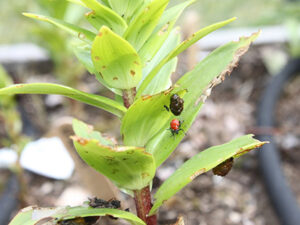
Damage to a lily by the scarlet lily beetle adult and larva.
If you spot the scarlet lily beetle for the first time in your area, reporting it helps track and manage its spread.
How to Report:
- Alberta Regional Lily Society:
Website: https://www.arls-lilies.org/resources/ - Olds College Ken Fry Ph.D:
Email: KFry@oldscollege.ca - Carlton University:
Website: https://lilybeetletracker.weebly.com/ - City of Edmonton:
You can also contact 311 or submit a pest report through the City’s YEG Pest Identification Service or environmental services.
When reporting:
- Include the date and location (with photos if possible)
- Describe the host plant and approximate beetle count
- Indicate whether you’ve taken control measures
Community Cooperation
Because the beetles can easily spread between neighboring gardens, community awareness and action are key. Garden clubs, community gardens, and neighborhood groups can help monitor and reduce the beetle’s impact across Edmonton.
Final Thoughts
The scarlet lily beetle poses a real challenge to Edmonton gardeners who love their lilies. But by combining strategies—such as choosing less susceptible varieties, using targeted controls like Dr. Doom spray and diatomaceous earth, and staying alert—you can protect your plants and limit the beetle’s spread. Reporting sightings also supports broader control efforts and helps keep Edmonton’s gardens beautiful and healthy.
May the only red in your garden be flowers, not freeloaders. Happy gardening everyone!

